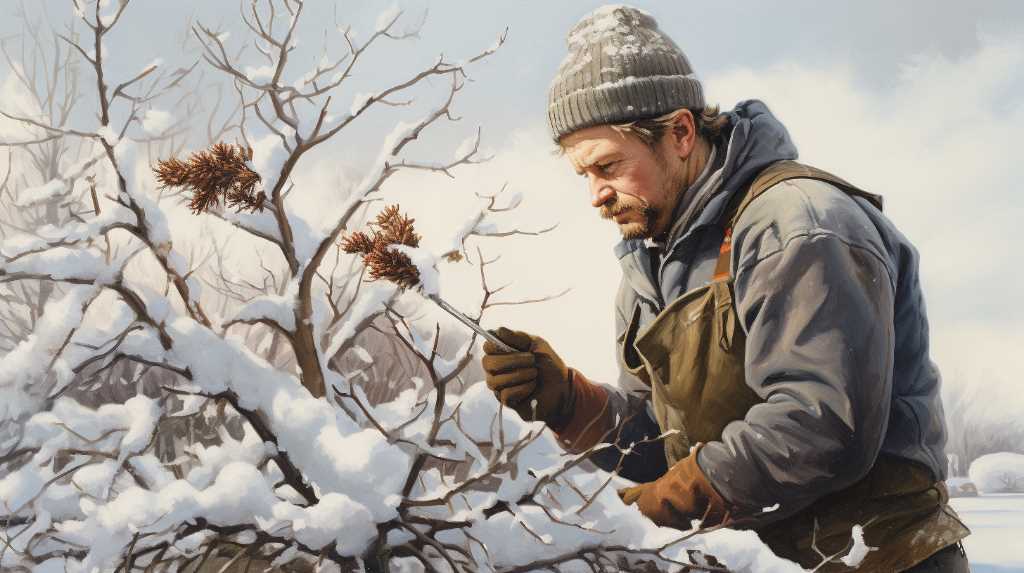Interviews with Experts
Essential Winter Tree Care and Maintenance Guide


As an avid tree lover, I’ve discovered that winter is a critical time for tree care and maintenance. Did you know that proper winter tree care can improve a tree’s overall health by up to 50%?
In this article, I’ll share essential tips and techniques for pruning, protecting, and preventing winter tree diseases. I’ll also explore watering strategies and offer guidance for young saplings.
Join me on this journey to ensure our beloved trees thrive during the colder months.
Pruning Techniques for Winter Trees
In my experience, winter pruning is crucial for maintaining the health and structure of trees. During this dormant season, it’s easier to identify and remove dead, diseased, or damaged branches. This not only improves the appearance of the tree but also prevents the spread of diseases and pests. Proper pruning techniques involve making clean cuts just outside the branch collar, which promotes healing and prevents decay.
It’s important to avoid over-pruning, as this can weaken the tree and make it more susceptible to winter damage. Additionally, pruning in winter helps stimulate new growth in the spring, leading to a healthier and more vibrant tree.
Transitioning to the next section, protecting trees from winter weather, is crucial to ensure the long-term success of your pruning efforts.


Protecting Trees From Winter Weather
To ensure the long-term success of our pruning efforts, it’s crucial to protect trees from the harsh winter weather. Winter can be a challenging time for trees, as they’re exposed to freezing temperatures, strong winds, and heavy snowfall.
One effective way to protect trees is by wrapping them with burlap or using tree wraps. These materials create a barrier that shields the trees from extreme cold and windburn.
Additionally, applying a layer of mulch around the base of the tree helps to insulate the roots and retain moisture.
It’s also important to prune any damaged or weak branches before winter arrives, as they can be more susceptible to breakage under the weight of snow and ice.
By taking these measures, we can safeguard our trees and promote their health and longevity during the winter season.
Now, let’s move on to the next section, where we’ll discuss preventing winter tree diseases.
Preventing Winter Tree Diseases
As winter weather poses challenges for trees, such as freezing temperatures and strong winds, it’s important to take preventive measures to protect them from winter tree diseases.


Here are some key steps to keep your trees healthy during the winter months:
- Prune trees to remove dead or diseased branches, improving air circulation and reducing the risk of infection.
- Apply dormant oil spray to suffocate overwintering insects and their eggs, preventing infestations in spring.
- Avoid overwatering trees, as excess moisture can lead to root rot and fungal diseases.
- Mulch around the base of trees to insulate the soil and regulate temperature, preventing stress and disease.
- Monitor for signs of disease such as discoloration, wilting, or unusual growth patterns, and take prompt action if needed.
Watering Strategies for Winter Trees
To effectively care for winter trees, I implement specific watering strategies that ensure their health and vitality during the colder months.
During winter, trees may not require as much water as they do in the warmer seasons, but it’s still crucial to provide them with adequate hydration. One important strategy is to water trees deeply and infrequently. This means giving them a good soaking every few weeks rather than frequent shallow watering. Deep watering encourages the tree’s roots to grow deeper, making them more resilient against the cold and drought.
Additionally, it’s important to water trees during periods of dry spells or when the ground isn’t frozen. This helps to prevent the tree from drying out and reduces the risk of winter desiccation.
Winter Tree Care for Young Saplings
For young saplings during winter, I focus on providing essential care and maintenance. Here are some key steps to ensure the health and well-being of these delicate trees:
- Protect the trunk: Apply tree guards or wraps to shield the saplings from harsh weather conditions and potential animal damage.
- Mulch: Surround the base of the saplings with a layer of organic mulch to insulate the roots and retain moisture.
- Watering: Water the saplings deeply before the ground freezes to help them withstand the winter months.
- Pruning: Remove any dead or damaged branches to promote healthy growth and prevent disease.
- Monitor for pests: Keep an eye out for signs of pests or diseases and take appropriate measures to control them.


Hello there! I’m Logan Foster, the green-thumbed social media marketer behind the vibrant world of 1800TreeGuy.com. With roots firmly planted in arboriculture, I’ve branched out to help clients cultivate their dream outdoor spaces, one leafy canopy at a time. My knack for nurturing nature is more than a profession—it’s a way of life.
When I’m not talking trees and teaching the art of arboreal care, you can find me cheering on the Bulldogs—my alma mater’s pride and my forever team. My environmental studies there didn’t just teach me about ecosystems; they instilled a lifelong passion for protecting our planet.
Off the clock, I’m an adventurer at heart. Whether it’s trekking the Appalachian trails, pedaling down a mountain path, or crafting guides to share the wonders of the wild, I’m happiest with soil under my nails and the sun on my face. And let’s not forget Yoda, my pug sidekick. He may not have mastered the art of stillness, but his joyful grins are my daily dose of happiness.
I’m all about making connections—between people and the great outdoors and between my clients and their ideal landscape visions. My approach is personal; every tree has a story, and every garden reflects its caretaker.
If you want to green your scene or share in my outdoor escapades, give me a shout on Instagram or Facebook. Let’s cultivate a conversation and grow a community rooted in a love for the lush life.








